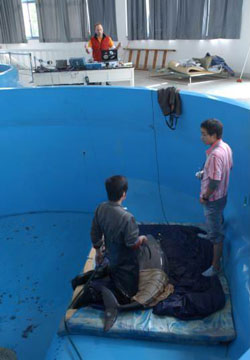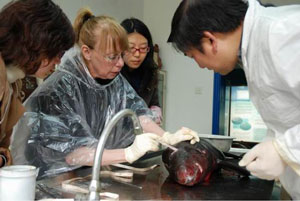
Newsroom
U.S., Russian Scientists Cooperate with IHB Scientists on the Research of Yangtze Finless Porpoises
Since March, 2010, scientists from Russia and United States has conducted research on the auditory ability and mechanism of Yangtze finless porpoises as well as the impact of underwater noise on their hearing with scientists of Institute of Hydrobiology, Chinese Academy of Sciences (IHB) for about 5 weeks in total. The experiments were performed with animals in captivity at the Baiji Dolphinarium, by using non-invasive Auditory Brainstem Response (ABR) method. The Russian scientists are Drs. Alexander Supin and Vladimir Popov, from Institute of Ecology and Evolution of the Russian Academy of Sciences, and the U. S. scientists are Drs. Darlene Ketten and Aran Mooney from Woods Hole Oceanographic Institution (WHOI) and Harvard Medical School.

Dr. Alexander Supin (L), a famous scientist in electrophysiological studies of cetacean hearing from Institute of Ecology and Evolution of the Russian Academy of Science, together with his colleague Dr. Vladimir Popov, was examining the measuring electrodes absorbing on the body of the Yangtze finless porpoises.
Yangtze finless porpoises rely on highly-developed sonar and acoustic communication systems for navigation, orientation, detection, prey location, and individual communication. Both the systems consist of two sub-systems, i.e. transmitter (emitting pulses of sounds) and receiver (hearing). Previous bioacoustic researches on Yangtze finless porpoises carried out at IHB mainly focused on their acoustic behavior, mechanism and characteristics of sonar signal, and ontogeny of acoustic behavior. Limited attention was paid to their hearing capability, their hearing pathway and temporal resolution, as well as the impact of underwater noise on their hearing.
As scheduled, the scientists from United States with scientists from IHB
performed a series of investigations on the auditory pathway, temporal resolution, and the structure of their hearing system of the Yangtze finless porpoises. Preliminary research results showed that Yangtze finless porpoises received sound via the fat-filled cavity in their lower jaw, same as other odontocetes. They are capable to detect sound with a temporal resolution less than 1 ms. Comparing with the previous investigated dolphins, the temporal resolution of Yangtze finless porpoises are more sensitive. The research findings will help to further reveal the auditory mechanism of Yangtze finless porpoises and the evolution and adaptation of their sonar in the complex river environment.

Dr. Aran Mooney (L) , postdoctoral scholar at Woods Hole Oceanographic Institution, was discussing experimental design with IHB Dr. Songhai Li, assistant researcher of IHB, guest investigator at Woods Hole Oceanographic Institution and Visiting Assistant Professor of University of Hawaii.
The scientists from the Russian Academy of Sciences, working with scientists of IHB, investigated the temporal effect of noise on the hearing of the Yangtze finless porpoises. They found that the hearing threshold of the animals would be evidently shifted once they were exposed to the noisy circumstance, even if the noise intensity was relatively weak. What’s worse, the shift of hearing threshold increases as the duration and intensity of noise increase. Once this happened, it takes a long period of rest before their hearing could finally get recovered. The research findings have significant value in the scientific evaluation of the effect of underwater noise, produced by human activities and vessels in the Yangtze River, on the hearing of the Yangtze finless porpoises. They are also beneficial for the researchers to explore ways to protect the endangered Yangtze finless porpoises.
The Research Group of Conservation Biology of Aquatic Animals at IHB has long been collaborating with Japanese National Research Institute of Fisheries Engineering on the acoustic behavior of freshwater cetacean in the Yangtze River. The current cooperative research with the American and Russian scientists is another high-level international cooperation. The visiting scientists are all well-known representatives in their respective research fields. During their stay in IHB, they also discussed the feasibility and research orientation for future cooperation with the IHB Research Group.
Baiji Dolphinarium, with its well-equipped facilities and solid scientific and technological foundation, provides a good platform for researchers to conduct valuable and unique research on Yangtze finless porpoises. So far, several achievements with great international academic influence have been accomplished here. Based on the scientific resources at Baiji Dolphinarium, IHB will build up a high-level international collaboration platform of cetacean so as to attract more world’s top cetacean scientists to cooperate and communicate with the local scientists.

Dr. Aran Mooney (top), postdoctoral scholar at Woods Hole Oceanographic Institution, examined the auditory ability of Yangtze finless porpoises.

Dr. Darlene Ketten, a marine biologist and neuro-anatomist specializing in functional analyses and biomedical imaging of cetacean sensory systems, is currently Senior Scientist at Woods Hole Oceanographic Institution, and Assistant Clinical Professor at Harvard Medical School. She was anatomizing a specimen of Yangtze finless porpoises collected in the Poyang Lake, Jiangxi province.

A group photo of the research team. First row from the left: Dr. Alexander Supin, Dr. Darlene Ketten, Dr. Vladimir Popov, Prof. Ding Wang. Second row from the left: Associate Professor Kexiong Wang, Dr. Songhai Li, Dr. Aran Mooney.